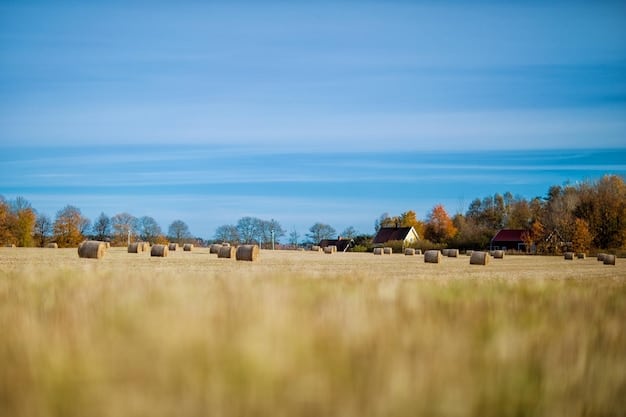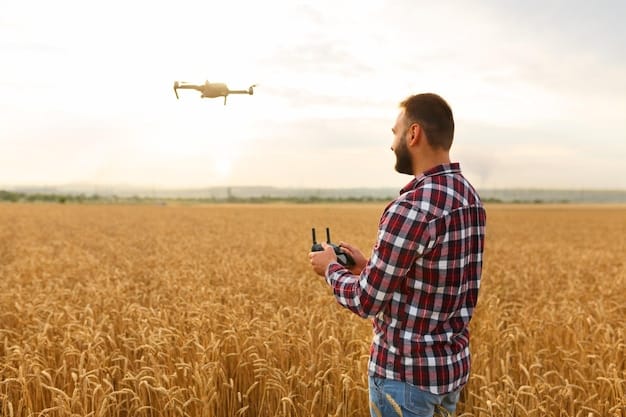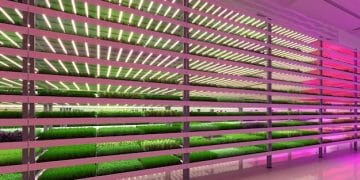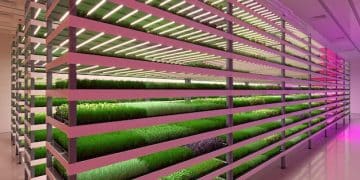US Farmers: Boost Profits with Predictive Analytics for Crops

US farmers can significantly maximize profits with predictive analytics by optimizing planting and harvesting strategies, leading to increased yields and reduced operational costs.
US farmers are constantly seeking ways to enhance their efficiency and profitability. One of the most promising avenues for achieving this is through the implementation of predictive analytics for crop planting and harvesting. This article delves into how these advanced techniques can revolutionize farming practices in the US, helping farmers make informed decisions and ultimately maximize profits with predictive analytics.
Understanding Predictive Analytics in Agriculture
Predictive analytics is transforming various sectors, and agriculture is no exception. By leveraging data and advanced algorithms, farmers can gain insights that were previously unattainable. This approach allows for more precise decision-making, leading to better resource allocation and improved yields.
In essence, predictive analytics involves using historical and real-time data to forecast future outcomes. For US farmers, this means analyzing data points such as weather patterns, soil conditions, and market prices to predict optimal planting and harvesting times, potential pest infestations, and yield forecasts. The integration of these insights enables farmers to make proactive adjustments that can significantly impact their bottom line.
Data Sources for Predictive Analytics
The effectiveness of predictive analytics heavily relies on the quality and variety of data sources. Here are some key data sources that US farmers can utilize:
- Weather Data: Historical and real-time weather data is crucial for predicting optimal planting and harvesting windows.
- Soil Data: Information on soil composition, moisture levels, and nutrient content helps farmers understand the specific needs of their crops.
- Market Data: Analyzing market trends and pricing data enables farmers to make informed decisions about which crops to plant and when to sell them.
- Sensor Data: Data from sensors placed in fields can provide real-time insights into crop health, pest presence, and environmental conditions.
By combining these data sources, farmers can create a comprehensive view of their operations and gain a competitive edge in the market. This comprehensive view allows farmers to maximize profits with predictive analytics by making informed decisions.
Predictive analytics empowers US farmers to make data-driven decisions, optimizing their operations for enhanced profitability and sustainability. By understanding and utilizing various data sources, farmers can unlock valuable insights that lead to improved yields and reduced costs.

Optimizing Crop Planting with Predictive Models
One of the primary applications of predictive analytics in agriculture is optimizing crop planting. This involves using data to determine the best time to plant specific crops, the ideal planting density, and the most suitable locations within a farm.
By leveraging predictive models, US farmers can avoid many of the pitfalls associated with traditional planting methods, such as planting crops too early or too late in the season. This leads to reduced risks of crop failure and increased chances of achieving optimal yields. These optimizations contribute significantly to efforts to maximize profits with predictive analytics.
Key Factors in Planting Optimization
Several key factors are considered when using predictive models to optimize crop planting:
- Temperature: Predicting temperature trends ensures that crops are planted when the conditions are most favorable for germination and growth.
- Rainfall: Analyzing rainfall patterns helps farmers determine the best time to plant to ensure adequate moisture levels without risking waterlogging.
- Soil Conditions: Understanding the nutrient composition and drainage characteristics of the soil allows farmers to select the most suitable crops for each location.
- Historical Data: Past planting successes and failures provide valuable data for refining predictive models.
Incorporating these factors into predictive models enables farmers to make more precise planting decisions, leading to improved crop performance and higher yields. The improved crop performance directly supports the goal to maximize profits with predictive analytics.
Predictive analytics offers US farmers a powerful tool for optimizing crop planting strategies. By considering key environmental and historical factors, farmers can make data-driven decisions that lead to more successful and profitable harvests. This technology is increasingly vital for modern farming operations.
Enhancing Harvesting Efficiency Through Data
Harvesting is a critical phase in the agricultural cycle, and its efficiency directly impacts a farmer’s profitability. Predictive analytics can play a significant role in optimizing harvesting operations by forecasting the best time to harvest crops, predicting potential yield volumes, and managing labor and equipment resources effectively.
With the help of predictive models, US farmers can move away from relying solely on traditional methods and instead embrace a data-driven approach that minimizes losses and maximizes the value of their crops. This enhanced efficiency is a key component when aiming to maximize profits with predictive analytics.
Practical Applications in Harvesting
Here are some practical applications of predictive analytics in harvesting:
- Optimal Harvest Timing: Predictive models can forecast the ideal harvest time based on crop maturity, weather conditions, and market prices.
- Yield Prediction: Estimating yield volumes allows farmers to plan their harvesting operations and storage capacity more effectively.
- Resource Management: By predicting labor and equipment needs, farmers can optimize resource allocation and minimize operational costs.
Farmers can ensure that crops are harvested at their peak quality and value by implementing these predictive strategies. The reduction of operational costs further enhances the ability to maximize profits with predictive analytics.
Predictive analytics offers US farmers invaluable tools for enhancing harvesting efficiency. By leveraging data to optimize timing, predict yields, and manage resources, farmers can ensure a more profitable and sustainable harvesting process.
Reducing Risks with Predictive Insights
Agriculture is inherently risky, with various factors such as weather, pests, and diseases posing significant threats to crop yields. Predictive analytics can help US farmers mitigate these risks by providing early warnings and insights that enable proactive intervention.
By analyzing historical data and real-time information, predictive models can identify potential issues before they escalate, allowing farmers to take preventive measures and protect their crops. Reducing risk is a crucial pathway to maximize profits with predictive analytics.

Strategies for Risk Mitigation
Here are some strategies for mitigating agricultural risks using predictive insights:
- Pest and Disease Prediction: Predictive models can forecast pest outbreaks and disease occurrences based on environmental conditions and historical data.
- Weather-Related Risk Management: Analyzing weather patterns enables farmers to prepare for extreme events such as droughts, floods, and frosts.
- Market Volatility: Predictive analytics can help farmers anticipate market fluctuations and make informed decisions about when to buy or sell their crops.
By adopting these risk mitigation strategies, farmers can safeguard their crops and financial stability.
Predictive analytics empowers US farmers to proactively manage risks, safeguarding their crops and ensuring a more stable and profitable agricultural operation. Early intervention based on predictive insights is essential for mitigating potential losses.
Integrating Technology for Predictive Agriculture
The successful implementation of predictive analytics in agriculture requires the integration of various technologies, including sensors, drones, data analytics platforms, and farm management software. US farmers must leverage these tools to collect, process, and interpret data effectively.
By integrating these technologies, farmers can create a seamless ecosystem that supports data-driven decision-making and optimizes all aspects of their operations. Optimized operations are critical for those who aspire to maximize profits with predictive analytics.
Essential Technologies for Predictive Agriculture
Here are some essential technologies for predictive agriculture:
- Sensors: Soil sensors, weather stations, and crop monitors provide real-time data on environmental conditions and crop health.
- Drones: Unmanned aerial vehicles (UAVs) equipped with cameras and sensors can capture aerial imagery and collect data on crop growth and stress levels.
- Data Analytics Platforms: These platforms process and analyze large volumes of data, generating insights and predictions that farmers can use to make informed decisions.
- Farm Management Software: Integrated software solutions help farmers manage their operations, track their resources, and implement predictive analytics strategies effectively.
The combined use of these technologies empowers farmers to make smarter decisions and enhance their overall productivity.
US farmers must embrace technology to fully realize the benefits of predictive analytics. By integrating sensors, drones, data analytics platforms, and farm management software, they can create a data-driven agricultural ecosystem that optimizes their operations and enhances their profitability. This comprehensive technological approach is the future of farming as it helps to maximize profits with predictive analytics.
Real-World Examples of Predictive Analytics Success
To fully appreciate the potential of predictive analytics in agriculture, it is helpful to examine real-world examples of its successful implementation. Several farmers and agricultural organizations in the US have already achieved significant benefits by adopting these technologies.
These success stories demonstrate the tangible impact of predictive analytics on crop yields, resource efficiency, and profitability, providing valuable insights for other US farmers looking to adopt similar strategies. These examples showcase the real potential to maximize profits with predictive analytics.
Case Studies in Predictive Agriculture
Here are a few case studies highlighting the successful use of predictive analytics in agriculture:
- Increased Yields: A corn farmer in Iowa used predictive models to optimize planting density and fertilizer application, resulting in a 15% increase in yield.
- Reduced Water Usage: A California vineyard implemented a predictive irrigation system, reducing water consumption by 20% while maintaining crop quality.
- Early Pest Detection: An apple orchard in Washington utilized predictive analytics to forecast pest outbreaks, allowing for targeted pesticide application and minimizing crop damage.
These examples show how predictive analytics can be tailored to different crops and regions to address specific challenges and improve overall performance.
These real-world examples serve as compelling evidence of the benefits of predictive analytics for US farmers. By learning from these success stories, farmers can gain the confidence and knowledge needed to implement similar strategies and achieve their own profitability goals.
| 🚜 Key Area | Brief Description |
|---|---|
| 🌱 Crop Planting | Optimizing planting times and densities for better yields. |
| 🌾 Harvesting | Improving harvesting efficiency through data-driven decisions. |
| 🛡️ Risk Mitigation | Reducing risks related to pests, weather, and market volatility. |
| 📊 Technology Integration | Combining sensors, drones, and analytics platforms for smarter farming. |
Frequently Asked Questions(FAQ)
▼
Predictive analytics uses data and algorithms to forecast future agricultural outcomes, helping farmers make informed decisions about planting, harvesting, and resource allocation, ultimately boosting profitability and reducing risks.
▼
Predictive models analyze weather, soil, and historical data to determine optimal planting times and densities, leading to better germination, growth, and higher yields. This reduces the risk of crop failure.
▼
Essential technologies include soil sensors, weather stations, drones, data analytics platforms, and farm management software. These tools collect and process data, providing insights for informed decision-making in agriculture.
▼
Predictive analytics forecasts optimal harvest times, predicts yield volumes, and manages labor and equipment needs effectively. This ensures crops are harvested at peak quality and reduces operational costs.
▼
Examples include increased corn yields in Iowa, reduced water usage in California vineyards using predictive irrigation, and early pest detection in Washington apple orchards, showcasing the tangible impact of predictive methods.
Conclusion
In conclusion, predictive analytics offers US farmers a powerful toolkit for optimizing their operations, mitigating risks, and enhancing their profitability. By embracing data-driven decision-making and integrating advanced technologies, farmers can ensure a more sustainable and prosperous future for their businesses.





